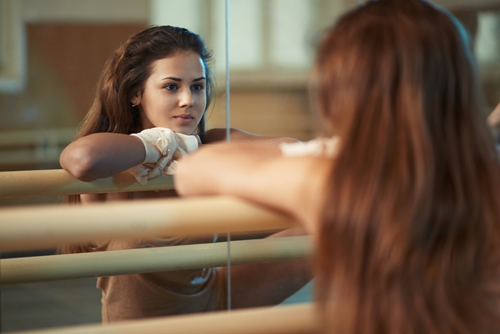Pirouetting around the kitchen or using a countertop as a barre might be fun, but it’s not safe or practical. A better place to practice is in a home ballet studio. Although building a home studio from scratch may sound overwhelming, there are simple and creative ways to create a home dance studio suitable for every household and wallet.
It’s not enough to just throw down a mat and prop up a mirror, however. To build a home ballet studio that will be truly beneficial, and not detrimental, to a dancer’s development, serious consideration should be given to the location of the studio, the materials used and what the studio will be primarily used for. Dancers might want a home studio to practice their skills in between classes, to put in extra preparation before a performance or to simply stretch and do conditioning exercises. Dedicated dancers looking for a quiet space to practice choreography and skills should build a larger studio, while those simply looking for a comfortable place to stretch can get away with a smaller space or portable studio.
Location, Location, Location
One of the most important aspects of building a home studio is determining its location. The main thing to consider is the floor type. Home studios should not be built in rooms and areas with concrete floors, like the basement or garage, since the hard and unforgiving surface can damage the joints. A room with a wood floor is the best option, as it is more forgiving. The space you select should be away from busy areas, be well-ventilated, and have a free wall where mirrors and a barre can be hung. If the only available space for building the studio is the basement or garage, you should build a padded wooden floor over the concrete.
Start From the Bottom
Even in rooms with hardwood floors, a thin layer of padding or laminate is necessary to provide comfort and proper support and decrease slipperiness. If you have a large budget, you can spring for marley floors, the standard floor type in ballet studios, however, rolls of the vinyl flooring, are very expensive. ISport suggested using PVS shower pan liner instead, which feels similar to marley but can be bought for a bargain, at around $4 to $8 per linear foot. The source also recommended installing an underlay of foam-lined subflooring or cushioned laminate to hardwood floors for further support.
[wpsm_video]https://www.youtube.com/embed/lxot4Fz3r6o?rel=0[/wpsm_video]
Use gaffer’s tape to attach the PVC or other top layer, making sure to smooth it out completely to get rid of any air bubbles. The source also suggested applying a layer of rosin on top to provide greater traction and cut down on the risk of falls and slips. If you’re installing a wooden floor in a garage, basement or other concrete area, varnished ACX plywood is relatively inexpensive and makes for a great base.
Install a Barre
A wall-mounted barre will maximize space in small rooms. While you can order a barre from a studio equipment company, there are cheaper alternatives that you can use to make your own barre. Wooden dowels with a diameter between one and three inches work well, are inexpensive and can be easily found at a hardware store. Basic handrails can also be used to create an inexpensive barre, though you should make sure that they are thick and sturdy and won’t easily break.
Add in Mirrors
Mirrors are essential to the home studio. Dancers need to be able to easily see their form, especially since their instructors will not be there to correct them. If dancers consistently perform a skill poorly, their bad form can become a habit without them even realizing it. You can find large mirrors at a hardware or home furnishing store, but a cheaper option is putting a bunch of small mirror tiles together to form one large mirror. ISport suggested using 12 x 12 inch mirrored tiles, which typically cost only $1 per square foot. Use extra strong sticky tabs or tape to securely adhere the tiles to the wall.
“A wall-mounted barre will maximize space in small rooms.”
Make it Portable
If you can’t permanently designate a room as a home dance studio, you can create a portable studio that can be hidden away when not in use. Although marley is expensive, it is available in smaller, padded versions, like a 4 x 6 feet piece. Purchase a free-standing barre instead of mounting one to the wall, and use a long mirror that’s set on wheels. With these portable pieces, it will take just seconds to put together your home ballet studio.
Creating a home studio gives dancers a quiet space to focus and practice their skills. It only takes a few components, all of which have cheap alternatives, to put together a studio that will serve as a valuable supplement to a dancer’s regular classes and routines.



